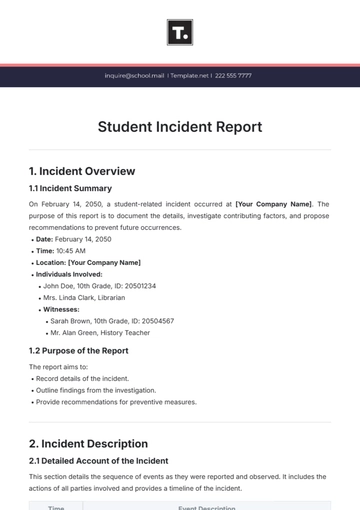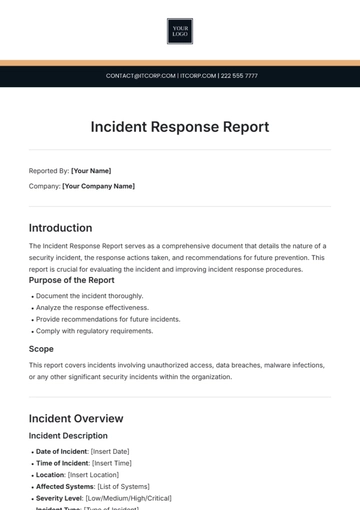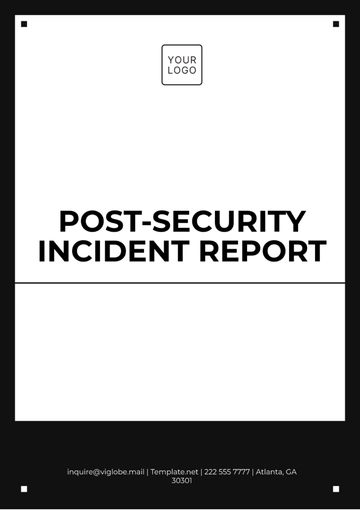Free Camping Incident Report

I. Introduction
This report provides a detailed account of an incident that occurred during one of [Your Company Name]'s camping expeditions in [2051]. The purpose of this report is to document the events leading up to the incident, the actions taken, and the measures proposed to prevent similar occurrences in the future. By maintaining a comprehensive record, [Your Company Name] demonstrates its commitment to safety, accountability, and continuous improvement in its operations.
Incident Overview: The incident took place at the camping grounds during a camping activity involving [20] participants. It resulted in injuries and environmental hazard.
Impact Summary: The immediate impact included [5] injury count and equipment damage. Further analysis will quantify long-term effects.
Stakeholders Involved: Those directly affected included campers, staff, and nearby communities, all of whom required swift action and clear communication.
Response Objective: The immediate goal was to minimize harm, ensure safety, and coordinate with emergency services where applicable.
Accountability: This report ensures transparency and assigns clear responsibility for addressing the incident comprehensively.
II. Description of the Incident
Understanding the root cause of the incident requires a precise breakdown of its events. This section delves into the timeline and factors contributing to the occurrence.
Location and Context: The incident occurred at [Campsite A], known for its steep terrain. Such conditions may have influenced the events.
Sequence of Events: The issue began when one of the campers slipped and escalated due to the camper holding on of the equipment.
Environmental Factors: Adverse weather, uneven terrain, or wildlife interaction played a significant role in exacerbating the situation.
Human Factors: A lapse in protocol or inadequate training among participants or staff contributed to the problem.
Duration: The incident lasted approximately a few minutes, requiring immediate containment and thorough follow-up actions.
III. Immediate Response Actions
This section outlines the measures taken in the immediate aftermath of the incident. Swift action helped mitigate the risks and address immediate concerns.
Evacuation Procedures: Affected individuals were moved to safety within [10] minutes. Emergency services were promptly contacted.
Medical Attention: Injured participants received first aid, and medical professionals were consulted for further evaluation.
Communication: Staff informed all stakeholders, including participants' families and local authorities, about the situation.
Containment Efforts: Measures were implemented to prevent the situation from worsening, such as setting up barriers or securing the area.
Documentation: Incident details were recorded in real time to ensure accurate reporting and analysis.
IV. Incident Analysis
A thorough analysis identifies root causes and contributing factors. This ensures actionable insights for future prevention.
Factor | Description | Severity (1-5) |
|---|---|---|
Environmental Conditions | Unexpected heavy rain intensified hazards. | 4 |
Equipment Failure | Tent structures collapsed under strong winds. | 3 |
Staff Training | Limited training on handling severe weather. | 3 |
Wildlife Interaction | Proximity to wildlife led to unexpected risks | 2 |
Participant Awareness | Campers lacked preparedness for harsh weather | 4 |
Environmental factors had the greatest impact, particularly heavy rain. Insufficient staff training and participant awareness highlight areas for improvement. While equipment issues were secondary, they also require attention to enhance safety.
V. Impact Assessment
Assessing the impact helps quantify the extent of the damage and prioritizes areas for immediate action and resource allocation.
Human Impact: Three participants sustained minor injuries, requiring medical evaluation but no hospitalization.
Equipment Damage: Damaged tents and camping tools accounted for a loss of approximately [$5,000].
Operational Delays: The incident disrupted the expedition schedule, resulting in a [3] days delay.
Reputation Risks: The event raised concerns among participants, necessitating proactive communication to rebuild trust.
Financial Implications: Immediate recovery actions cost approximately [$ value], with potential additional costs for policy improvements.
VI. Preventative Measures
To prevent future incidents, [Your Company Name] is committed to implementing robust safety and operational changes.
Enhanced Training: Staff will undergo rigorous training on handling emergencies in diverse terrains.
Improved Equipment: Investments in weather-resistant camping gear and safety tools will minimize future risks.
Safety Protocol Updates: Comprehensive safety checklists and real-time weather monitoring systems will be introduced.
Participant Orientation: All participants will receive pre-expedition training on safety measures and environmental awareness.
Feedback Mechanisms: Post-expedition surveys will help identify potential risks and refine protocols.
VII. Financial Summary
A detailed financial breakdown provides insights into incident-related expenses and potential investment needs.
Category | Cost |
|---|---|
Emergency Response | $10,000 |
Equipment Replacement | $12,000 |
Medical Services | $5,000 |
Staff Training Programs | $8,000 |
Communication Expenses | $5,000 |
Equipment replacement accounted for the largest portion of costs, highlighting the need for durable materials. Investment in training programs will also yield long-term safety improvements.
VIII. Stakeholder Feedback
Collecting and analyzing feedback ensures continuous improvement and stakeholder confidence.
Participants' Concerns: Campers emphasized the need for better pre-expedition preparation and real-time communication.
Staff Insights: Employees highlighted the importance of advanced weather forecasting tools and additional training.
Local Authorities' Input: Emergency services recommended establishing predefined protocols for common campsite issues.
Company Leadership: Leadership emphasized the value of long-term investments in safety technology and training.
Feedback Trends: Consistent themes included improved communication, enhanced training, and better equipment.
IX. Action Plan
This section outlines the immediate and long-term actions needed to address identified issues.
Action Item | Timeline | Responsible Party |
|---|---|---|
Procure durable equipment | 1 month | Procurement Team |
Staff emergency training | 3 months | Training Department |
Update safety protocols | 2 months | Safety Committee |
Implement weather monitoring | 2 weeks | Technology Division |
Participant safety workshops | Ongoing | Customer Experience |
The outlined actions prioritize immediate needs, such as equipment upgrades and protocol updates. Long-term initiatives, including staff training and participant workshops, will ensure sustained safety improvements.
X. Conclusion
To reinforce safety standards and enhance operational efficiency, [Your Company Name] will prioritize implementing the action plan within designated timelines. The company will also establish a Safety Review Board to monitor progress and recommend additional improvements. By fostering a culture of safety, collaboration, and transparency, [Your Company Name] aims to prevent similar incidents and uphold its reputation as a trusted camping provider.
- 100% Customizable, free editor
- Access 1 Million+ Templates, photo’s & graphics
- Download or share as a template
- Click and replace photos, graphics, text, backgrounds
- Resize, crop, AI write & more
- Access advanced editor
Document events accurately with the Camping Incident Report Template from Template.net. Fully editable and customizable, this template is perfect for reporting accidents, injuries, or other incidents during camping trips. Personalize it quickly in our AI Editor Tool with the necessary details. Its professional layout ensures clarity and efficiency in maintaining safety records.
You may also like
- Sales Report
- Daily Report
- Project Report
- Business Report
- Weekly Report
- Incident Report
- Annual Report
- Report Layout
- Report Design
- Progress Report
- Marketing Report
- Company Report
- Monthly Report
- Audit Report
- Status Report
- School Report
- Reports Hr
- Management Report
- Project Status Report
- Handover Report
- Health And Safety Report
- Restaurant Report
- Construction Report
- Research Report
- Evaluation Report
- Investigation Report
- Employee Report
- Advertising Report
- Weekly Status Report
- Project Management Report
- Finance Report
- Service Report
- Technical Report
- Meeting Report
- Quarterly Report
- Inspection Report
- Medical Report
- Test Report
- Summary Report
- Inventory Report
- Valuation Report
- Operations Report
- Payroll Report
- Training Report
- Job Report
- Case Report
- Performance Report
- Board Report
- Internal Audit Report
- Student Report
- Monthly Management Report
- Small Business Report
- Accident Report
- Call Center Report
- Activity Report
- IT and Software Report
- Internship Report
- Visit Report
- Product Report
- Book Report
- Property Report
- Recruitment Report
- University Report
- Event Report
- SEO Report
- Conference Report
- Narrative Report
- Nursing Home Report
- Preschool Report
- Call Report
- Customer Report
- Employee Incident Report
- Accomplishment Report
- Social Media Report
- Work From Home Report
- Security Report
- Damage Report
- Quality Report
- Internal Report
- Nurse Report
- Real Estate Report
- Hotel Report
- Equipment Report
- Credit Report
- Field Report
- Non Profit Report
- Maintenance Report
- News Report
- Survey Report
- Executive Report
- Law Firm Report
- Advertising Agency Report
- Interior Design Report
- Travel Agency Report
- Stock Report
- Salon Report
- Bug Report
- Workplace Report
- Action Report
- Investor Report
- Cleaning Services Report
- Consulting Report
- Freelancer Report
- Site Visit Report
- Trip Report
- Classroom Observation Report
- Vehicle Report
- Final Report
- Software Report





























